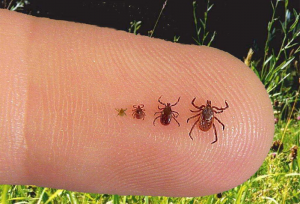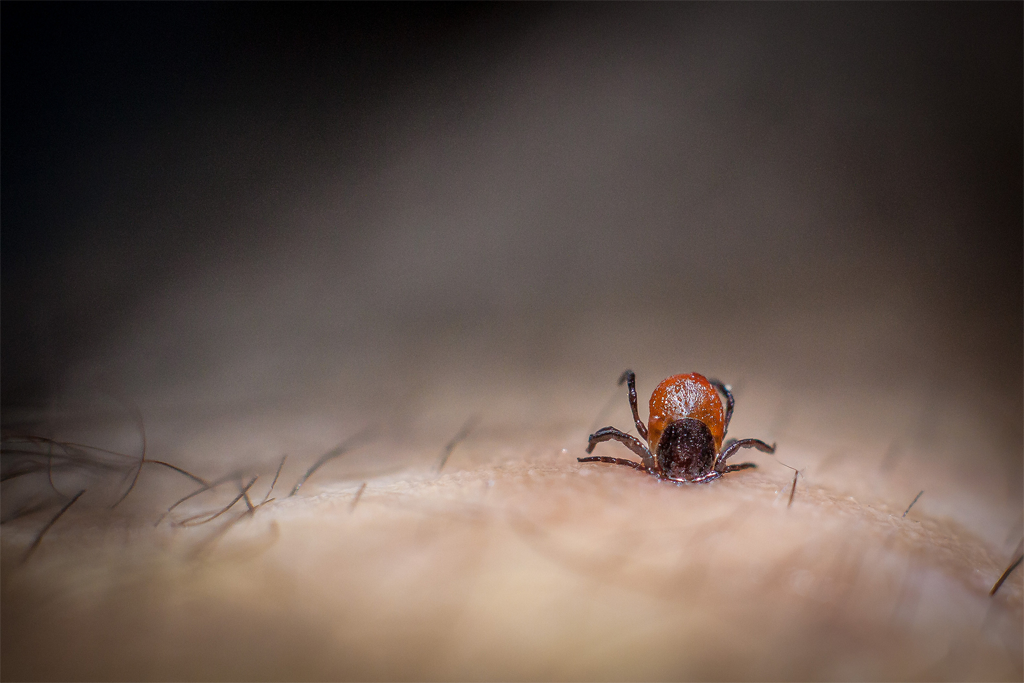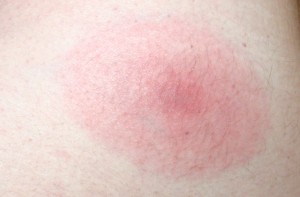By Dr. Craig A. Maxwell
Lyme disease is an acute inflammatory disease caused by a bacterial infection, known as Borrelia burgdorferi, which is commonly spread and transmitted through deer tick bites. One misconception associated with Lyme disease is that all deer ticks are infected by this contagious bacterium. This is not true. It is important to be armed with the facts when heading outdoors this fall.
Deer ticks live in shady, moist, humid areas at ground level. They will cling to tall grass, brush and shrubs, usually no more than 18-24 inches off the ground. They can be found in lawns, gardens or along the outskirts of wooded areas. Spreading inland from the Northeastern U.S. into the Midwest, deer ticks can travel by deer and bird migration, infected rodents, or even by hitching a ride on pets during road trips traveling across the country! While not able to fly or jump, ticks find their hosts through direct contact. Once on the skin, the tick normally climbs up the body in search for a warmer, more protected location.
About 30,000 cases of Lyme disease are reported to the CDC each year. This number does not account for all cases, as Lyme disease is currently one of the most misdiagnosed diseases known. In fact, based on three studies from 2012, the CDC now believes that doctors actually diagnose and treat more than 300,000 cases of Lyme disease each year. This new number still does not account for all the cases of Lyme disease which are not diagnosed correctly! Furthermore, deer ticks are not the only carriers of B. burgdorferi. Once bitten by an infected tick, humans can carry B.burgdorferi in blood, breast milk, semen, vaginal fluid, saliva, and tears.
Best Ways to Prevent Lyme Disease
Avoiding deer ticks altogether is the best way to prevent Lyme disease. Because ticks like to live within tall grasses and wooded areas, I recommend wearing long sleeves and pants when gardening, hiking, camping, or partaking in other outdoor activities. It can also be a good idea to tuck your shirt into your pants, and your pants into your socks. This can help to keep ticks from coming in direct contact with your skin. When done working or playing outside, I suggest you check the following areas of the body, as they can make for luxurious tick homes: inside your belly button, within your hair, backs of knees, behind ears, and under your arms.
Also known as black-legged ticks, deer ticks are similar in appearance to that of their close relative: the spider. Having eight jointed legs, reddish bodies, with black dorsal markings, the female deer tick is about the same size as a sesame seed. Male deer ticks are slightly smaller. As the small parasite feeds on its host, it’s body enlarges and becomes engorged with blood.

Recipe for Natural Tick Deterrent
Try the following recipe to keep both ticks, and harmful chemicals, away from you and your family.
Ingredients:
2 cups witch hazel
1 cup water
10 drops eucalyptus oil
5 drops lavender oil
5 drops lemongrass oil
Directions:
Mix all ingredients and pour into a spray bottle. Apply on skin and clothing every hour while outdoors.
How to Remove a Tick
Aside from basic prevention, early detection is your next best strategy against Lyme disease. If you find that a tick has made its way onto your body and is clinging to your skin, it’s best to act quickly. It can take up to 24 to 48 hours before the tick begins to transmit any bacteria into your body.
Many different methods are known for removing a tick. The goal is to try and remove the entire tick, without leaving any of its mouth parts stuck in the skin. The CDC recommends using fine tweezers, gently grasping the tick as close to the skin as possible, while slowly pulling away from your skin, and then washing the affected area with rubbing alcohol. Check out the video below for a quick visual representation of their method.
Special tick removal tools can be even more effective than using fine tweezers. I recommend considering the Contech Tick Twister Pro. This device works to remove the entire head of the tick, without squeezing the abdomen, thus decreasing your risk of infection. It can be used for humans, dogs, cats, horses, and other types of pets or livestock.
Common Symptoms of Lyme Disease
Initially, Lyme disease can go unnoticed and many times misdiagnosed. With flu-like symptoms that can include a stiff neck, chills, fever, swollen lymph nodes, headaches, fatigue, muscle aches, and joint pain, this contagious disease is difficult to detect and easy to confuse with a possible influenza bug. However, one tell-tale sign which can help distinguish this disease from a typical virus or sickness is a large, expanding skin rash around the area of the tick bite. However, depending on the study, this rash is visible after the infection is transmitted in only 40-70 percent of those infected. In more advanced cases of the disease, nerve problems and joint pain, especially in the knees, may occur.
Co-infection with Babesia (Babesiosis), Bartonella (Bartonellosis, also known as cat scratch fever), and Ehrlichia (Ehrlichosis) can occur at the same time through a single bite. Symptoms may not occur for weeks, months or years after a bite.
Borrelia, Babesia, Bartonella, and Ehrlichia
The following symptoms were excerpted from Diagnostic Hints And Treatment Guidelines For Lyme And Other Tick Borne Illnesses, by Joseph J. Burrascano Jr., M.D. (Fifteenth Edition 2008).
Borrelia
(Borreliosis, neuroborreliosis; also known as Lyme Disease)
Spread primarily though the bite of infected ticks that live on a wide range of mammalian species; secondary human-to-human transmission through semen, breast milk, and possibly in utero.
Bladder dysfunction
Burning or stabbing sensations
Cardiac impairment
Change in bowel function
Chest pain
Confusion
Depression
Difficulty thinking
Difficulty with concentration and reading
Difficulty with speech, writing
Difficulty finding words; name blocking
Disorientation: getting lost, going to wrong places
Disturbed sleep: too much, too little, fractionated, early awakening
Ears/Hearing: buzzing, ringing, ear pain, sound sensitivity
Exaggerated symptoms or worse hangover from alcohol
Eyes/Vision: double, blurry, increased floaters, light sensitivity
Facial paralysis (Bell’s palsy)
Fatigue, tiredness, poor stamina
Forgetfulness
Headache
Heart block
Heart murmur
Heart palpitations
Heart valve prolapse
Increased motion sickness
Irritability
Irritable bladder
Joint pain or swelling
Lightheadedness
Mood swings
Muscle pain or cramps
Neck creaks & cracks
Neck stiffness, pain
Numbness
Pelvic pain
Poor attention
Poor balance
Poor short-term memory
Problem absorbing new information
Pulse skips
Rib soreness
Sexual dysfunction or loss of libido
Shooting pains
Shortness of breath; cough
Skin hypersensitivity
Sore throat
Stiffness of the joints or back
Swollen glands
Testicular pain
Tingling
Tremor
Twitching of the face or other muscles
Unavoidable need to sit or lay down
Unexplained breast pain
Unexplained fevers, sweats, chills or flushing
Unexplained hair loss
Unexplained menstrual irregularity’
Unexplained milk production
Unexplained weight loss or gain
Upset Stomach or abdominal pain
Vertigo
Wooziness
Babesia
(Babesiosis)
Babesia is a protozoan spread by ticks, blood transfusion, and in utero. Despite there being 20+ known forms to date, current testing only looks for two of them.
Air hunger
Cough
Fatigue
Fevers
Headache
Hemolysis
Imbalance without true vertigo
Mild encephalopathy
Shaking chills
Sweats
Bartonella
(Bartonellosis, also known as cat scratch fever)
Spread by bites from infected ticks and in utero
abnormal liver enzymes
encephalopathy
endocarditis
flu-like malaise
headache
hemolysis with anemia
hepatomegaly
high fever
immune deficiency
jaundice
lymphadenopathy
myalgias
myocarditis
papular or angiomatous rash
somnolence
sore throat
splenomegaly
weakened immune response
Ehrlichia
(Ehrlichiosis)
Bites from infected ticks
elevated liver enzymes
headaches
myalgias
ongoing fatigue
persistent leukopenia
thrombocytopenia
Not all laboratories are able to check for these tick-borne infections. I recommend IgeneX for this very specialized testing.
Should you test positive for any of these infections, your physician will prescribe the appropriate medication for a recommended length of time. This often, but not always, clears the infection up. After antibiotic treatment, I feel it is wise to boost the immune system in an effort to achieve complete recovery.
Natural Ways to Boost Your Immune System
The following herbs and supplements can help you boost your immune system, which can be impaired by Lyme disease:
1) Ginseng: Used as a natural way to boost energy levels and immunity for over 2000 years in Eastern medicine.
2) Astragalus: Adaptogen herb used to help deal with a variety of stressors, as well as boosting the immune system.
3) Reishi mushrooms: Can be eaten fresh or dried. Also can be mixed into any type of food or drink recipe.
4.) Foundation Vitamins: Offer a full spectrum of professional grade vitamins and minerals. I recommend three tablets once a day.
5.) Vitamin D3 5,000 IU: Most adults will achieve optimal blood levels by taking one daily.
6.) Probiotic Formula: One daily to replace the good GI bacteria, which are reduced by the antibiotic therapy.
7.) Exercise. I recommend walking or swimming 20 minutes or more 3-4 times a week. Be sure to get medical clearance from your doctor before beginning an exercise program.
8.) Diet: Should include 6-8 or more servings of fresh fruits and vegetables daily. Organic if possible.
9.) No tobacco or alcohol
In my experience, targeted antibiotic therapy followed by immune system boosters offers the best treatment results. When co-infections exist, your doctor will usually need to treat them separately.
Keep in mind that it’s best to always discuss herbal and nutritional guidance with your doctor before attempting self-care.









